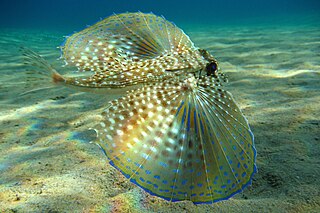This page is based on this
Wikipedia article Text is available under the
CC BY-SA 4.0 license; additional terms may apply.
Images, videos and audio are available under their respective licenses.

The Triglidae, commonly known as sea robins or gurnard, are a family of bottom-feeding scorpaeniform fish. They get their name from the orange ventral surface of the species in the Western Atlantic and from large pectoral fins, which, when swimming, open and close like a bird's wings in flight. The large surface area of the fins also permits the fish to glide short distances above the water surface, much like a flying fish.

Dactyloptena orientalis, known commonly as the Oriental flying gurnard or purple flying gurnard among other vernacular names, is a species of marine fish in the family Dactylopteridae. Their name is derived from the French word 'gurnard' meaning to grunt, for the grunting sound this fish makes.

The bluefin gurnard or Pacific red gurnard is a species of fish in the family Triglidae, the sea robins and gurnards. It is found in the western Indian Ocean and the western Pacific Ocean, being common around Australia and New Zealand at depths down to 200 metres (660 ft). Its length is up to 60 centimetres (24 in).

Gurnard's Head is a prominent headland on the north coast of the Penwith peninsula in Cornwall, England, UK. The name is supposed to reflect the fact that the rocky peninsula resembles the head of the gurnard fish.

Gurnard is a village and civil parish on the Isle of Wight, two miles to the west of Cowes. Gurnard sits on the edge of Gurnard Bay, enjoyed by the Gurnard Sailing Club.

The flying gurnard, also known as the helmet gurnard, is a bottom-dwelling fish of tropical to warm temperate waters on both sides of the Atlantic Ocean. On the American side, it is found as far north as Massachusetts and as far south as Argentina, including the Caribbean and Gulf of Mexico. On the European and African side, it ranges from the English Channel to Angola, including the Mediterranean. This is the only species in the monotypic genus Dactylopterus. Similar and related species from the genus Dactyloptena are found in the Indian and Pacific Oceans.

The tub gurnard, Chelidonichthys lucerna is a species of bottom-dwelling coastal fish with a spiny armored head and fingerlike pectoral fins used for crawling along the sea bottom. The tub gurnard is a reddish fish with blue pectoral fins.
Bluefin or Blue Fin and variants may refer to:

Smallscaled gurnards (Chelidonichthys) is a fish genus in the family Triglidae.

The spiny red gurnard is a species of searobin native to the northwestern Pacific Ocean where they occur at depths of from 25 to 615 metres. This species grows to a length of 40 centimetres (16 in) TL. This species is of commercial importance as a food fish.
C. spinosus may refer to:

Lepidotrigla is a genus of searobins found in the Atlantic, Pacific and Indian oceans.
In the 10th edition of Systema Naturae, Carl Linnaeus described the Pisces as:
Always inhabiting the waters; are swift in their motion and voracious in their appetites. They breathe by means of gills, which are generally united by a bony arch; swim by means of radiate fins, and are mostly covered over with cartilaginous scales. Besides the parts they have in common with other animals, they are furnished with a nictitant membrane, and most of them with a swim-bladder, by the contraction or dilatation of which, they can raise or sink themselves in their element at pleasure.

The Cape gurnard is a species of sea robin native to the Western Indian Ocean where they occur at depths of from 10–390 metres (33–1,280 ft) and in such countries as Mozambique and Namibia. The species is 75 centimetres (30 in) TL in length and lives maximum to the age of 16. This species is of commercial importance as a food fish.
The Gabon gurnard is a species of sea robin native to the East Central and Western Atlantic Ocean where they occur at depths of from 15–200 metres (49–656 ft) and also in Cape Verde and the Gulf of Guinea. The species maximum length is 32 centimetres (13 in) TL, but can be as small as 20 centimetres (7.9 in). This species is of commercial importance as a food fish.
The longfin gurnard is a species of sea robin that can be found in such seas as the Aegean and Black Seas and from theBritish Isles to Mauritania. They are also common in the East Atlantic Ocean where they occur at depths of 170 metres (560 ft). The species is 34 centimetres (13 in) TL. This species is of commercial importance as a food fish.
The lesser gurnard is a species of sea robin native to Western Indian Ocean, southern Mozambique and can also be found in Table Bay, South Africa where they occur at depths of 150 metres (490 ft). The species is 35 centimetres (14 in) TL long and can live up to 7 years. This species is of commercial importance as a food fish.









